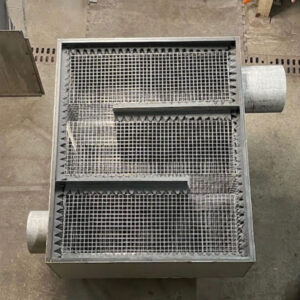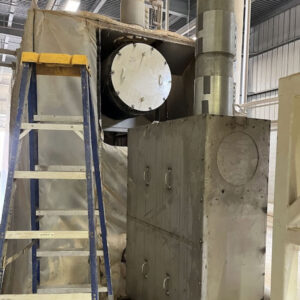Rice hulls play a crucial role in our Turf Builder products, ensuring even nutrient distribution and ease of application across your lawn. As part of the production process, these lightweight hulls are suctioned out of railcars and then blown into the plant for processing using two large blowers.
However, this process presented a significant challenge: the powerful blowers emitted a consistently loud whirring noise, registering around 95 decibels. Prolonged exposure to noises at that level can cause damage to hearing cells, potentially leading to permanent hearing loss and contributing to physical and psychological problems such as stress, high blood pressure, and cardiovascular disease.
 Recognizing the need for a solution, our team took proactive steps to mitigate this noise pollution. “We knew we had to come up with something to address this noise problem, and I initially tried to work with a vendor, but they did not have a solution,” said Kevin Krabacher, Senior West Process Engineer. Krabacher then leveraged his expertise to develop an in-house remedy. “So I came up with a rough design, which is essentially a damper box that has insulation on the inside, defined the dimensions and then I met with one of the fabricators from our R&D pilot plant. He ordered the material, put it together and then installed it over the summer.”
Recognizing the need for a solution, our team took proactive steps to mitigate this noise pollution. “We knew we had to come up with something to address this noise problem, and I initially tried to work with a vendor, but they did not have a solution,” said Kevin Krabacher, Senior West Process Engineer. Krabacher then leveraged his expertise to develop an in-house remedy. “So I came up with a rough design, which is essentially a damper box that has insulation on the inside, defined the dimensions and then I met with one of the fabricators from our R&D pilot plant. He ordered the material, put it together and then installed it over the summer.”
The custom-designed silencer successfully reduced the noise emanating from the rice hull blower from 95 decibels – comparable to the sound of a typical chainsaw – to a more comfortable ambient level of 55 decibels, similar to that of a household fan. This substantial improvement created a safer and significantly less noisy working environment for our employees and considerably lessened noise disturbance for the local community.
 Following the success of this application, the benefits of noise reduction were further extended to other areas of our production facility. Two additional silencers have been installed in the EZSeed packaging area.
Following the success of this application, the benefits of noise reduction were further extended to other areas of our production facility. Two additional silencers have been installed in the EZSeed packaging area.
“We were losing capacity on some of our vacuum systems because they were too loud and people were trying to dampen it,” Krabacher said. “This solution helped ensure we could discharge all the air we needed to and still have the suction required to run our vacuum system at 100%.”

